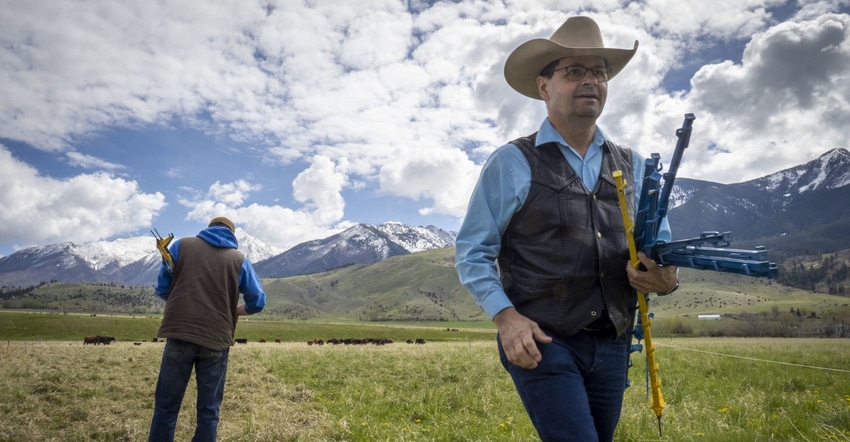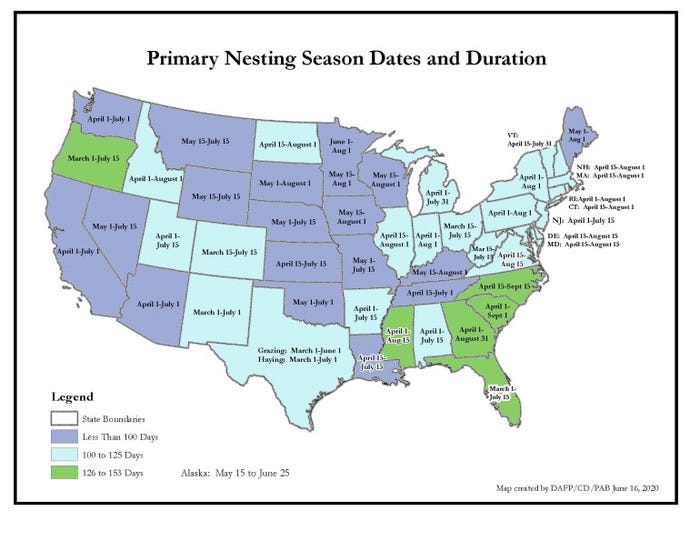
As the Ukraine-Russia conflict continues to draw into question the amount of world grain supplies, USDA took another step May 26 to improve production capacity in the United States with the announcement that Conservation Reserve Program participants who are in their final year of the CRP contract can get into fields after the nesting season ahead of the official October 1 expiration date.
Zach Ducheneaux, administrator of USDA’s Farm Service Agency, explains the decision was born out of work across the department to help ensure that producers have the tools they need to take advantage of production opportunities. “The rising food prices overseas resonate here as higher commodity prices. And we want producers to be able to take advantage of that just a little sooner without any economic penalty,” Ducheneaux says.
Participants approved for this one-time, voluntary termination will not have to repay rental payments, a flexibility implemented this year to help mitigate the global food supply challenges caused by the Russian invasion of Ukraine and other factors.
If approved for voluntary termination, preparations can occur after the conclusion of the primary nesting season. Producers will then be able to hay, graze, begin land preparation activities and plant a fall-seeded crop before Oct. 1, 2022.
Many of the northern states, the nesting period does not end until August 1. For that land in colder climates, this flexibility may allow for better establishment of a winter wheat crop or better prepare the land for spring planting.

Ducheneaux says it is possible in some regions that producers could plant a short-season soybean or wheat crop yet this growing season if the nesting period falls in July as many states do.
An estimated 3.4 million acres of enrolled CRP acres expired this year, although USDA accepted more than 2 million acres through the CRP general sign-up. He explains just under 55% of expiring acres put in a proposal to re-enroll. He anticipates as the West still deals with a historic drought that many of the acres that are expiring are coming out in the Midwest region and other places where there’s ample moisture for producers to take a look at other options.
“Putin’s unjustified invasion of Ukraine has cut off a critical source of wheat, corn, barley, oilseeds and cooking oil, and we’ve heard from many producers who want to better understand their options to help respond to global food needs,” says Ducheneaux. “This announcement will help producers make informed decisions about land use and conservation options.”
Looking beyond current CRP year
Senate Agriculture Committee ranking member John Boozman, R-Ark., welcomed the action by USDA, but while Secretary of Agriculture Tom Vilsack was before the Senate Agriculture Committee on the day the announcement was made, he said USDA may need to provide additional flexibilities.
“In the 2014 Farm Bill, landowners enrolled in the Conservation Reserve Program were given an opportunity to end their contracts early without penalty,” Boozman says. “We should give serious consideration to this penalty-free incentive again until grain production returns to normal. I believe this flexibility would allow potentially millions of acres to return to food production. The world cannot afford for prime farmland to lie fallow.”
As the war in Ukraine persists and food supply remains a significant concern, Boozman has continued to pressure USDA for an update to its CRP policy.
“Allowing domestic producers to scale-up capacity to aid those desperately in need globally is a commonsense policy to help address the food crisis and bring down prices here at home. Flexibilities have been provided in the past with success, so at a time like this when we’re facing food security challenges, it’s necessary to use every tool in the toolbox to allow more acres of land to return to food production,” Boozman says.
Vilsack says USDA has taken a look at the program and most of the acres in CRP “are not really very productive” as the agency has tried to focus on highly erodible lands.
Vilsack says he does believe USDA will provide additional flexibilities “when and if it’s necessary.” This has been done in the past with haying and grazing. “We’ll continue to look for ways in which we could provide assistance, but right now more than a million acres are coming out of that program into production.”
Additional conservation program opportunities
USDA also announced additional flexibilities for the Environmental Quality Incentives Program and Conservation Stewardship Program.
FSA is mailing letters to producers with expiring acres that detail this flexibility and share other options, such as re-enrolling sensitive acres in the CRP Continuous signup and considering growing organic crops. Producers will be asked to make the request for voluntary termination in writing through their local USDA Service Center.
Since CRP land typically does not have a recent history of pesticide or herbicide application, USDA is encouraging producers to consider organic production. USDA’s Natural Resources Conservation Service provides technical and financial assistance to help producers plan and implement conservation practices, including those that work well for organic operations, such as pest management and mulching. Meanwhile, FSA offers cost-share for certification costs and other fees.
Participants can also choose to enroll all or part of their expiring acres into the Continuous CRP signup for 2022. Important conservation benefits may still be achieved by re-enrolling sensitive acres such as buffers or wetlands. Expiring water quality practices such as filter strips, grass waterways, and riparian buffers may be eligible to be reenrolled under the Clean Lakes, Estuaries, and Rivers (CLEAR) and CLEAR 30 options under CRP. Additionally, expiring continuous CRP practices such as shelterbelts, field windbreaks, and other buffer practices may also be re-enrolled to provide benefits for organic farming operations.
If producers are not planning to farm the land from their expiring CRP contract, the Transition Incentives Program may also provide them two additional annual rental payments after their contract expires on the condition that they sell or rent their land to a beginning or veteran farmer or rancher or a member of a socially disadvantaged group.
Producers interested in the Continuous CRP signup, CLEAR 30, or TIP should contact FSA by Aug. 5, 2022.
USDA also encourages producers to consider NRCS conservation programs, which help producers integrate conservation on croplands, grazing lands and other agricultural landscapes. EQIP and CSP can help producers plant cover crops, manage nutrients and improve irrigation and grazing systems.
Additionally, the Agricultural Conservation Easement Program, or state or private easement programs, may be an option. In many cases, a combination of approaches can be taken on the same parcel. For example, riparian areas or other sensitive parts of a parcel may be enrolled in continuous CRP and the remaining land that is returned to farming can participate in CSP or EQIP and may be eligible to receive additional ranking points.
Additionally, NRCS is also offering new flexibility for EQIP and CSP participants who have cover cropping included in their existing contracts. NRCS will allow participants to either modify their plans to plant a cover crop (and instead shift to a conservation crop rotation) or delay their cover crop plans a year, without needing to terminate the existing contract. This will allow for flexibility to respond to market signals while still ensuring the conservation benefits through NRCS financial and technical assistance for participating producers.
About the Author(s)
You May Also Like






